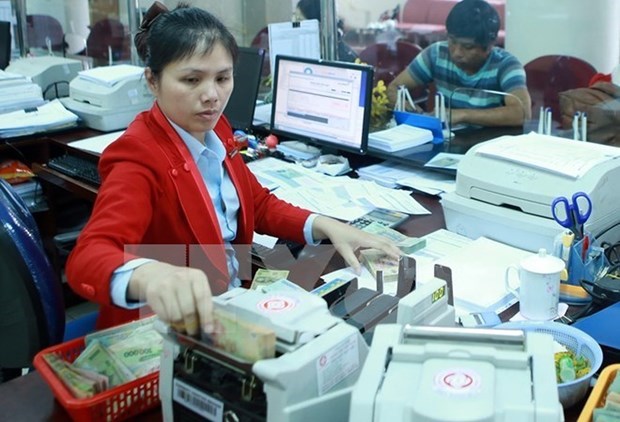Microfinance sees bright prospects due to rising demands
Amidst the growing demands for microfinance in Vietnam, the potential of expansion for the sector is high, but experts have advised that microfinance organisations should work harder to develop in a sustainable manner.
 Illustrative image (Source: VNA)
Illustrative image (Source: VNA) Hanoi (VNA) – Amidst the growing demands for microfinance in Vietnam, the
potential of expansion for the sector is high, but experts have advised that microfinance
organisations should work harder to develop in a sustainable manner.
Microfinance is one of the more effective tools for poverty reduction, especially among low-income, disadvantaged and vulnerable groups, including women.
According to Deputy Governor of the State Bank of Vietnam (SBV) Nguyen Kim Anh, with its prominence of simple borrowing conditions, no mortgage needed, flexibility in payment, and preferential interest rates, microfinance is considered a leverage for women to strengthen their confidence.
The capital resources also enable women to engage in production activities to increase incomes and get rid of poverty.
Statistics show that up to 85 percent of microfinance customers are poor women.
Dr. Dang Thu Thuy from the Vietnam Academy of Banking said that women have fewer chances than men to access services from official organisations or credit institutions. Meanwhile, statistics show that the ratio of repaying the loans among female customers is higher than that among male borrowers.
In Vietnam, microfinance is provided through three sectors – financial institutions; non-governmental organisations, political-social organisations, and charities and social funds; and private financial activities.
By September 30 last year, Vietnam had seen four microfinancial organisations licensed by the SBV, with a total capital of over 1.37 trillion VND (???). At the end of 2017, the four organisations had a total of 438,534 customers. Deposits in the organisations reached nearly 2.7 trillion VND, a surge of 185 percent over 2016, helping maintain a low ratio of bad debts at 0.3 percent of their total outstanding balance.
However, many economists pointed out that microfinance’s scale remains small with few products and services, while the legal framework for the sector has not yet been completed with modest support in financial management for customers.
SBV Deputy Governor Dao Minh Tu said that the demand for microfinance capital is increasing, while the capital growth of microfinance projects and programmes is facing difficulties due to limited support from the State budget.
According to experts, obstacles in accessing official microfinance resources may lead people to unofficial resources with the latent risk of “black credit” expansion.
Tu held that it is necessary to issue regulations giving more favourable conditions for the connections of credit institutions with microfinance organisations, while fostering collaboration among ministries, sectors and localities as well as socio-political organisations to shorten the time of issuing licences for microfinance programmes and projects.
The SBV deputy governor also stressed the need to continue standardising the management of microfinance organisations through the completion of the sector’s legal corridor and encourage its sustainable growth, while designing new services to suit Vietnam’s real life conditions.
In a country with around 9 million poor households, or about 7 percent of the population, that have difficulty in accessing financial resources, there is room for microfinance to further develop. Experts held that the sector is eying up opportunities to complete its organisation and management method towards safer and more sustainable growth.–VNA
Microfinance is one of the more effective tools for poverty reduction, especially among low-income, disadvantaged and vulnerable groups, including women.
According to Deputy Governor of the State Bank of Vietnam (SBV) Nguyen Kim Anh, with its prominence of simple borrowing conditions, no mortgage needed, flexibility in payment, and preferential interest rates, microfinance is considered a leverage for women to strengthen their confidence.
The capital resources also enable women to engage in production activities to increase incomes and get rid of poverty.
Statistics show that up to 85 percent of microfinance customers are poor women.
Dr. Dang Thu Thuy from the Vietnam Academy of Banking said that women have fewer chances than men to access services from official organisations or credit institutions. Meanwhile, statistics show that the ratio of repaying the loans among female customers is higher than that among male borrowers.
In Vietnam, microfinance is provided through three sectors – financial institutions; non-governmental organisations, political-social organisations, and charities and social funds; and private financial activities.
By September 30 last year, Vietnam had seen four microfinancial organisations licensed by the SBV, with a total capital of over 1.37 trillion VND (???). At the end of 2017, the four organisations had a total of 438,534 customers. Deposits in the organisations reached nearly 2.7 trillion VND, a surge of 185 percent over 2016, helping maintain a low ratio of bad debts at 0.3 percent of their total outstanding balance.
However, many economists pointed out that microfinance’s scale remains small with few products and services, while the legal framework for the sector has not yet been completed with modest support in financial management for customers.
SBV Deputy Governor Dao Minh Tu said that the demand for microfinance capital is increasing, while the capital growth of microfinance projects and programmes is facing difficulties due to limited support from the State budget.
According to experts, obstacles in accessing official microfinance resources may lead people to unofficial resources with the latent risk of “black credit” expansion.
Tu held that it is necessary to issue regulations giving more favourable conditions for the connections of credit institutions with microfinance organisations, while fostering collaboration among ministries, sectors and localities as well as socio-political organisations to shorten the time of issuing licences for microfinance programmes and projects.
The SBV deputy governor also stressed the need to continue standardising the management of microfinance organisations through the completion of the sector’s legal corridor and encourage its sustainable growth, while designing new services to suit Vietnam’s real life conditions.
In a country with around 9 million poor households, or about 7 percent of the population, that have difficulty in accessing financial resources, there is room for microfinance to further develop. Experts held that the sector is eying up opportunities to complete its organisation and management method towards safer and more sustainable growth.–VNA











